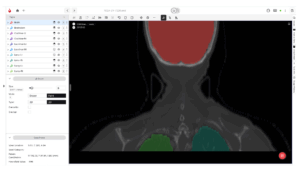Accurate medical image annotation is the foundation of effective healthcare AI — powering early disease detection, treatment planning, and research. From pathology to radiology, the right tool helps teams maintain precision, meet compliance standards like HIPAA, and collaborate efficiently.

With numerous platforms available, selecting one that supports DICOM, scales with growing datasets, and integrates seamlessly with AI workflows is crucial. Here’s what makes a strong medical image annotation platform, followed by five standout tools for 2025.
What Sets an Exceptional Medical Image Annotation Tool Apart?
Specialised clinical workflows demand tailored annotation solutions. Key features to consider include:
- Native support for medical formats: Seamless handling of DICOM and other clinical imaging files.
- Specialised annotation capabilities: Precise segmentation tools and custom labelling workflows for diverse clinical use cases.
- Data security & compliance: GDPR and HIPAA compliance, plus features like audit logs, role-based access, and encryption.
- Easy collaboration: Built-in task assignment, label validation, and progress tracking for multi-user teams.
- Scalability & integration: Ability to manage large datasets and integrate with storage solutions or AI pipelines.
Before shortlisting, verify the platform meets these core requirements to ensure it can handle both current and future project needs.
1. Ango Hub
Ango Hub is designed for medical teams seeking efficient and scalable annotation workflows while maintaining regulatory compliance.

Highlights
- 2D and 3D visualisation with native DICOM support
- Advanced labeling, measurement, and segmentation tools
- Enterprise-grade security with GDPR and HIPAA compliance
- Role-based workflows for better collaboration
- Integration options for machine learning pipelines
These solutions include workflows that support multi-user review processes, anatomical labeling, and segmentation masks.
2. MD.ai
MD.ai is widely used by hospitals and researchers who need robust image labeling tools with collaboration features.
Highlights
- Compatibility with several medical formats and DICOM support
- Advanced tools for segmentation, polygons, and bounding boxes
- Workflow and annotator management for training
- HIPAA-compliant infrastructure
- Cloud storage and sharing capabilities
MD.ai is well-regarded in academic settings and commonly used in research publications. However, teams planning to transition to real-world deployments might need enterprise-grade scalability and seamless integration capabilities.
3. Labelbox
Labelbox is a versatile platform to support image, video, and text annotation.
Highlights
- Configurable workflows for classification and segmentation
- SDKs and APIs for customisation
- Strong security features
When image annotation is just one part of a broader dataset, Labelbox can be a good option for teams working across multi-modal data pipelines. While it is efficient, teams with specific clinical workflows might need additional setup to fine-tune it for different use cases.
4. Supervisely
For teams working extensively with 3D and volumetric medical data, Supervisely offers robust capabilities.
Highlights
- Comprehensive support for 3D DICOM images
- AI-assisted annotation and segmentation tools
- Scripting and custom plugin options
- On-premises deployment available
Supervisely offers better flexibility and visualisation features that can help handle complex medical imaging workflows. To get the most out of its capabilities, teams can plan for setup and compliance configuration.
5. MONAI Label
Developed specifically for medical imaging and AI training, MONAI Label is an ideal open-source tool designed for research and experimentation.
Highlights
- Integration with advanced tools such as ITK-SNAP and 3D Slicer
- AI-assisted annotation workflows
- Support for multiple medical image formats
- Amazing customisation capabilities offered for deep research use
For research teams experimenting with model-in-the-loop workflows, MONAI Label is highly recommended. With a primary focus on flexibility, it provides better control and experimentation opportunities for technically equipped teams.
Conclusion
Configurable interfaces and compliance-focused infrastructure can help teams manage clinical datasets more effectively and adapt to changing project demands. As demand for annotation grows more complex, spanning CT, MRI, and ultrasound, an effective platform must keep pace with data scale and label precision. While pathology teams may require pixel-level segmentation of small entities, radiology teams may require slice-by-slice annotations.
Checklist for selecting a medical image annotation platform
Choosing the right platform requires balancing technical, regulatory, and operational needs. Use the following checklist to evaluate potential solutions:
- What image formats must the platform support?
- How important is regulatory compliance for the project?
- How experienced and large is the annotation team?
- Does the platform align with healthcare standards?
- Can the platform scale as project requirements grow?
